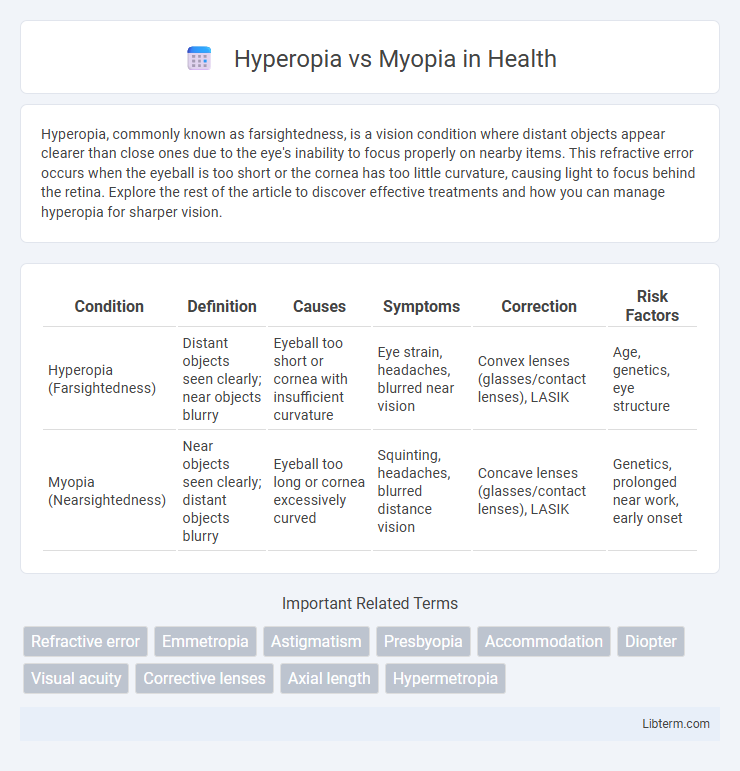Hyperopia, commonly known as farsightedness, is a vision condition where distant objects appear clearer than close ones due to the eye's inability to focus properly on nearby items. This refractive error occurs when the eyeball is too short or the cornea has too little curvature, causing light to focus behind the retina. Explore the rest of the article to discover effective treatments and how you can manage hyperopia for sharper vision.
Table of Comparison
| Condition | Definition | Causes | Symptoms | Correction | Risk Factors |
|---|---|---|---|---|---|
| Hyperopia (Farsightedness) | Distant objects seen clearly; near objects blurry | Eyeball too short or cornea with insufficient curvature | Eye strain, headaches, blurred near vision | Convex lenses (glasses/contact lenses), LASIK | Age, genetics, eye structure |
| Myopia (Nearsightedness) | Near objects seen clearly; distant objects blurry | Eyeball too long or cornea excessively curved | Squinting, headaches, blurred distance vision | Concave lenses (glasses/contact lenses), LASIK | Genetics, prolonged near work, early onset |
Understanding Hyperopia and Myopia
Hyperopia, commonly known as farsightedness, occurs when the eye focuses images behind the retina, causing difficulty in seeing nearby objects clearly, while myopia, or nearsightedness, results from images focusing in front of the retina, leading to blurry distance vision. Hyperopic individuals often experience eye strain and headaches due to constant focusing efforts, whereas myopic individuals typically struggle with distant objects but have clear near vision. Accurate diagnosis of hyperopia and myopia through comprehensive eye exams ensures effective correction using lenses or refractive surgery tailored to individual refractive errors.
Key Differences Between Hyperopia and Myopia
Hyperopia, or farsightedness, causes distant objects to appear clear while close objects are blurry due to light focusing behind the retina. Myopia, or nearsightedness, results in clear vision up close but blurry vision at a distance because light focuses in front of the retina. Key differences include the focal point of light relative to the retina and the affected range of vision, with hyperopia impairing near vision and myopia impairing distance vision.
Causes of Hyperopia and Myopia
Hyperopia occurs when the eyeball is too short or the cornea has insufficient curvature, causing light to focus behind the retina, leading to difficulty seeing close objects clearly. Myopia results from an elongated eyeball or excessively curved cornea, which causes light to focus in front of the retina, making distant objects appear blurry. Both refractive errors stem from anatomical variations in the eye's shape that affect how light is focused on the retina.
Symptoms of Hyperopia vs Myopia
Hyperopia symptoms include blurred vision for close objects, eye strain, headaches, and difficulty focusing on near tasks. Myopia symptoms involve blurred distance vision, squinting, headaches, and eye fatigue when viewing faraway objects. Both conditions can cause visual discomfort but affect focus at opposite ranges, requiring specific corrective lenses.
Diagnosis and Eye Testing Procedures
Hyperopia and myopia are diagnosed through comprehensive eye examinations that include visual acuity tests and refraction assessments using phoropters or autorefractors to determine the exact lens prescription needed. Retinoscopy and slit-lamp examinations help identify refractive errors by measuring how light rays focus on the retina, distinguishing between farsightedness (hyperopia) and nearsightedness (myopia). Advanced diagnostic tools like wavefront aberrometry provide detailed mapping of optical imperfections, enhancing the precision of eye testing procedures for accurate detection and treatment planning.
Treatment Options for Both Conditions
Hyperopia treatment commonly includes prescription eyeglasses or contact lenses with convex lenses to correct farsightedness by converging light rays onto the retina. Myopia is typically managed using concave lenses in glasses or contacts that diverge light to focus it correctly on the retina, and options like orthokeratology or refractive surgery (LASIK, PRK) are also effective. Advanced treatments such as multifocal intraocular lenses and newer pharmacological approaches are emerging for both conditions to improve visual outcomes and reduce dependence on corrective eyewear.
Risk Factors and Prevention
Hyperopia, or farsightedness, often results from an eyeball that is too short or a cornea with insufficient curvature, while myopia, or nearsightedness, arises from an elongated eyeball or excessively curved cornea. Risk factors for hyperopia include aging, family history, and certain eye diseases, whereas myopia is strongly associated with genetic predisposition, prolonged near work, and limited outdoor activities during childhood. Preventive measures focus on regular eye exams, balanced visual tasks, protective eyewear, and encouraging outdoor time to reduce myopia progression and manage hyperopia effectively.
Impact on Daily Life
Hyperopia (farsightedness) causes difficulty focusing on close objects, leading to eyestrain and headaches during tasks like reading or using digital devices, impacting productivity and comfort. Myopia (nearsightedness) results in blurred distance vision, making activities such as driving, sports, or recognizing distant signals challenging and potentially hazardous. Both refractive errors can reduce quality of life, but appropriate corrective lenses or refractive surgery significantly improve visual function and daily performance.
Surgery for Hyperopia and Myopia
Laser eye surgery for hyperopia (farsightedness) often involves procedures like LASIK or PRK that reshape the cornea to improve near vision by steepening its curvature. Myopia (nearsightedness) surgery uses similar techniques but focuses on flattening the cornea to reduce its refractive power and enhance distance vision. Both conditions benefit from personalized surgical plans based on corneal thickness, patient age, and refractive error magnitude to optimize visual outcomes.
Frequently Asked Questions (FAQs)
Hyperopia, or farsightedness, causes distant objects to appear clearer while near objects remain blurry, whereas myopia, or nearsightedness, makes close objects clear and distant objects blurry. Common FAQs include questions about corrective options such as glasses, contact lenses, and refractive surgery, as well as symptoms like eye strain and headaches. Treatment effectiveness varies based on severity, with early diagnosis and proper correction essential for preventing further vision deterioration.
Hyperopia Infographic

 libterm.com
libterm.com